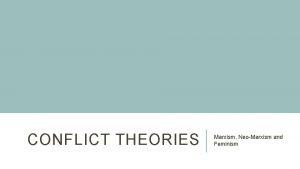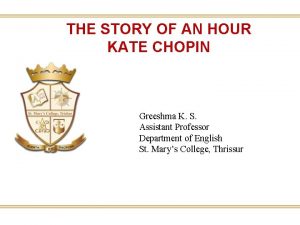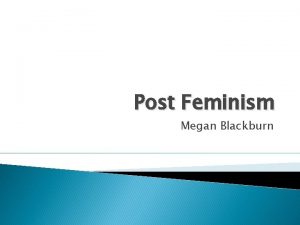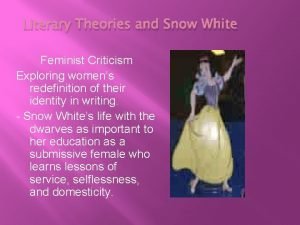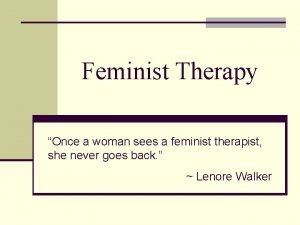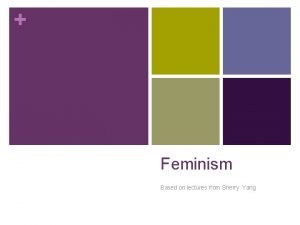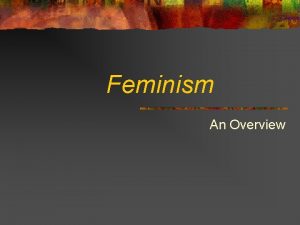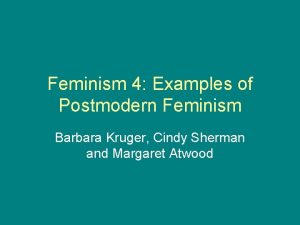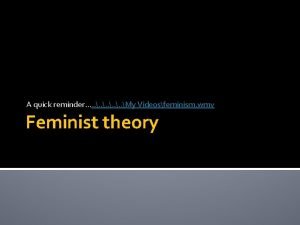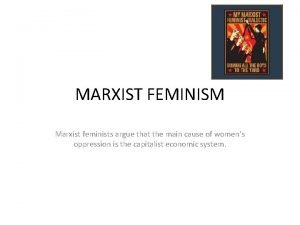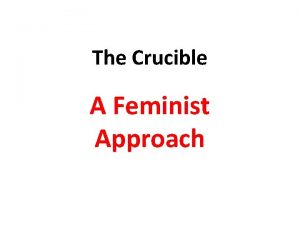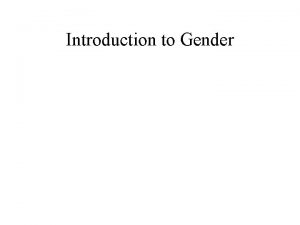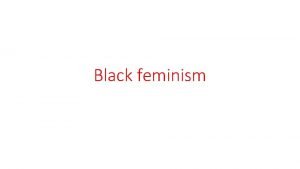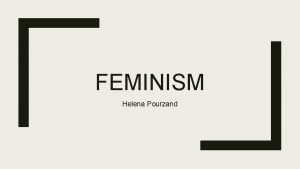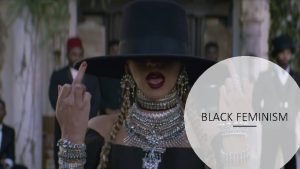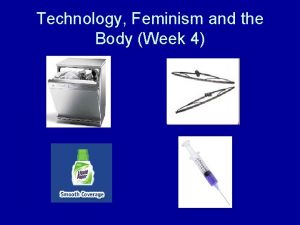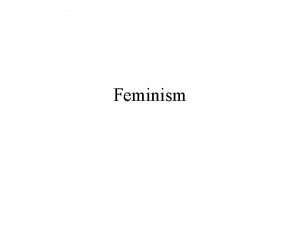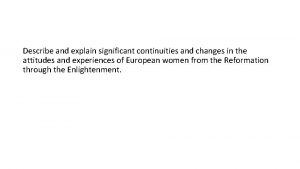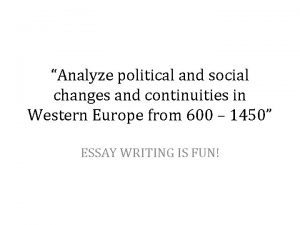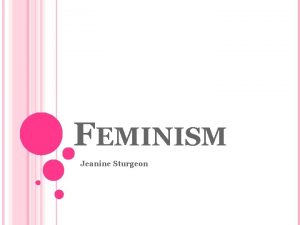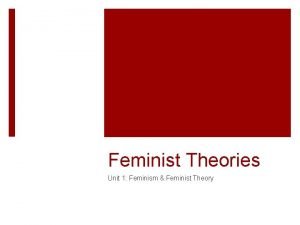Feminism Documents on the continuities and changes through


















- Slides: 18

Feminism Documents on the continuities and changes through its historical waves

Enlightenment, Revolutions, World Wars

Feminist Beginnings ◦ Feminist movements took shape mostly in Europe and North America ◦ Believed revolutionary ideas of liberty and equality applied to women also ◦ First organized women’s rights conference = in Seneca Falls, NY in 1848 ◦ Leading feminist and speaker = Elizabeth Cady Stanton

Major Goals of the Feminist Movement ◦ Access to schools and universities ◦ Access to more professions ◦ Suffrage (the right to vote) ◦ 1893 = New Zealand is the first country to grant all women the right to vote ◦ 1920 = 19 th Amendment passed in the U. S. ◦ Most countries did not grant female suffrage until after WWI

Some Accomplishments of the Movement ◦ Increased entrance to universities and increasing women’s literacy rates ◦ Many U. S. states passed laws to let women control and manage their own property and wages ◦ Increased access to professions ◦ Medicine opened to a few ◦ Teaching ◦ Social work (invented by Jane Addams) ◦ Nursing (professionalized by Florence Nightingale)

Opposition to Feminism ◦ Many viewed feminists as selfish and willing to sacrifice their families and/or the nation in order to pursue individual goals ◦ Some argued: the strains of education and life in the world outside the home would cause reproductive damage ◦ Result: it would depopulate the nation What many believed women should keep doing

What were women fighting for at various waves?

This document written by Olympe de Gourges wishes to hold women in all equality with that of men. In response to the French Declaration of The Rights of men and because women Were at the forefront of the French Revolution She proposes rights and liberties accorded To women as they were to men. Her audience Is the fellow women who still bear chains Of oppression and inspires to fight for the Ideals of the Revolution and have them Firmly applied to women as well.

PROTO-FEMINISM MEANS BEFORE IT WAS A MAJOR MOVEMENT. MARY WOLLSTONECRAFT ARGUIES FOR EDUCATION AND DRAWS A COMPARISON TO THE OPPORTUNITIES ACCORDED MEN WITH EDUCATION VS THOSE WHICH MARGINALIZE WOMEN AND MAKE THEM WEAK. SHE EQUATES EDUCATION WITH PROFESSIONALISM, REASON AND POWER WHILE THOSE WHO DO NOT HAVE IT AS DEPENDENT AND SUBVERSIVE TO MEN. SHE ADVOCATES FOR EQUAL EDUCATION.

IN Document #3, Elizabeth Cady Stanton Advocates for liberties similar to the Declaration of Independence (like Doc #1) ◦ Inspired by Locke and Jefferson, Cady-Stanton instructs that government must be derived from the consent of the governed and demands the same liberties, rights and freedoms accorded to men. She then lists the grievances and abuses of men toward women including voting, marriage, property, wages, due process, employment, and education to name a few. She writes for the purpose of demonstrating that women will protest and fighte to achieve these rights.

In document #4 anti-slavery and feminist Sojourner Truth provides a speech (improvised) identifying the correlation between abolition of slavery and feminism ◦ Sojourner qualifies and quantifies the deserving of respect and rights based on her contributions, suffering and reason including shame. Her purpose was to inspire the audience and provide a sense of solidarity ( the idea that they are all in this together for the basis of righteousness).

DOCUMENT #5 ILLUSTRATES THE EFFECTS OF THE MOVEMENT OF THE SUFFRAGISTS (THOSE FIGHTING TO GAIN THE RIGHT TO VOTE) WAS A STRUGGLE THAT TOOK TWO WORLD WARS AND WOMEN’S ROLES TO GAIN. WOMENS ECONOMIC ROLES IN THE FACTORIES WHILE MEN FOUGHT.

IN DOCUMENT #6 VIRGINIA WOOLF WHO MAY HAVE BENEFITTED FROM WOLSTONCRAFT( DOC #2) TIES THE ALLEGORY OF SHAKESPEARE SISTER AS THE HISTORICAL TRADITION OF PATRIARCHY AND HOW WOMEN WERE MARGINALIZED TO BE WED, LABELED AS WITCHES, DENIED AN EDUCATION AND FORGOTTEN BECAUSE THEY WERE DENIED THE SAME EDUCATION. SHE CONTINUES THAT IT HAPPENS STILL TODAY (1929) TO INSPIRE WOMEN TO CONTINUE TO FIGHT AGAINST PATRIARCHY THROUGH EDUCATION. NOTE: SHE WAS HOME SCHOOLED AND HAD ACCESS TO THE GREATEST INTELLECTUAL MINDS AT THE TIME UNLIKE SO MANY OTHER WOMEN.

In Document 7, Simone de Beauvior indicates the economic dependence of women to men ◦ The historical purse strings that prevented women from making economic decisions without the consultation of their husbands rendered women unequal regardless of the right to vote. Her purpose is to educate women to fight for economic rights in addition to political and cultural rights.

Document #8 indicates women becoming more increasingly involved in the workforce ◦ Sincle women have had far more opportiunites than married, divorced and or widowed. Reasons for this may include the “cult of domesticity” requiring women to quit upon engagement, prevent paid time off for pregnancy and denying higher education for women. The glass ceiling indicate women not being able to climb the corporate ladder because of these reasons.

Document #9 equates access to education with ◦ This census date illustrates access to higher education favorable more to men than women. Note that the age-set is during higher procreative years amongst women and indicates their choice of education or motherhood was problematic from 19121984

DOCUMENT 10: FEMINISM IS FOR EVERYBODY, BELL HOOKS (2000) INDICATES THE REASONING FOR THE CURRENT WAVE OF FEMINISM AND THE ESSENTIAL NEED TO FIGHT FOR POLITICAL, ECONOMIC AND CULTURAL RIGHTS EQUL TO MEN AND WOMEN. BELL HOOKS INDICATES CULTURAL PROBLEMS INDICATING THE SOME PERCEIVE FEMINIST WOMEN WHO “HATE MEN” AND THE VIOLENCE WHICH CURRENTLY PERSISTS AGAINST WOMEN

Thesis: From the French Revolution to modern Day women having been at the forefront of the battle for enlightened rights enshrined politically by constitutions, economically have been stunted by their traditional domestic roles as caregivers and limited education and culturally by being denied rights of liberty and cultualy egalitarianism, women would fight through the centuries for these rights. ◦ Synthesis: Women in Dar Al Islam being allowed divorce and property rights, spiritual equality and right to own a business in the Sharia (but limited in lagal testimony, secluded in harems and having to wear the Hijab) ◦ Women in China (Song/Ming/Qing) establiushing concubinage, binding feet in Neo-Confucianism, Submissive to men in 5 Confucian relationships ◦ Women in Hinduism ( SE Asia, South Asia: Gjurati Kingdoms, Sriyivaja, Mahajapit Kingdoms, Khmer Kingdoms) child brides, dowry, Sati ◦ Women in Sudanic Africa: Bridewealth, matrilineal inheritance, cattle raisers (earners)
 Elizabeth mulroney
Elizabeth mulroney Neena haridas
Neena haridas Structuralist formalist meaning
Structuralist formalist meaning Marxism and feminism similarities
Marxism and feminism similarities Through and through sawing advantages
Through and through sawing advantages The story of an hour analysis feminism
The story of an hour analysis feminism What is post feminism
What is post feminism Snow white theories
Snow white theories Characteristics of patriarchy
Characteristics of patriarchy Principles of feminism
Principles of feminism What is feminism
What is feminism Feminism
Feminism Barbara kruger marilyn monroe
Barbara kruger marilyn monroe Postmodern feminism
Postmodern feminism Feminist waves
Feminist waves Marxist feminism theory
Marxist feminism theory Feminism in the secret life of bees
Feminism in the secret life of bees Feminism in the crucible
Feminism in the crucible Marxist feminism example
Marxist feminism example



